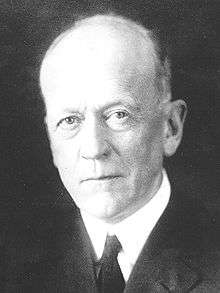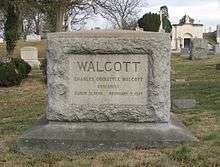Charles Doolittle Walcott
| Charles D. Walcott | |
|---|---|
 | |
| Born |
March 31, 1850 New York Mills, New York, USA |
| Died |
February 9, 1927 (aged 76) Washington, DC, USA |
| Nationality | United States |
| Fields | Paleontology |
| Institutions |
Smithsonian Institution US Geological Survey |
| Notable awards |
Bigsby Medal (1895) Wollaston Medal (1918) Mary Clark Thompson Medal (1921) |
| 3rd Director of the United States Geological Survey | |
|
In office 1894 – 1907 | |
| Preceded by | John Wesley Powell |
| Succeeded by | George Otis Smith |
Charles Doolittle Walcott (March 31, 1850 – February 9, 1927) was an American paleontologist,[1] administrator, running the Smithsonian Institution from 1907 to 1927, and geologist.[2] He became known for his discovery in 1909 of well-preserved fossils in the Burgess Shale of British Columbia, Canada, see history of the Burgess Shale. He was described by Stephen Jay Gould as "the finest symbol that I have ever encountered for the embodiment of conventional beliefs."[2]
Early life
Walcott was born in New York Mills, New York. His grandfather, Benjamin S. Walcott, moved from Rhode Island in 1822. His father, also Charles Doolittle Walcott, died when Charles Jr. was only two. Walcott was the youngest of four children.[3] He was interested in nature from an early age, collecting minerals and bird eggs and, eventually, fossils. He attended various schools in the Utica area but left at the age of eighteen without completing high school, the end of his formal education.[4] His interest in fossils solidified as he became a commercial fossil collector.[4] On January 9, 1872, Walcott married Lura Ann Rust, daughter of the owner of a farm in New York where Walcott made one of his most important trilobite discoveries (Walcott-Rust quarry). She died on January 23, 1876. Walcott's interest in fossils led to his acquaintance with Louis Agassiz of Harvard, who encouraged him to work in the field of paleontology; later that year, he began work as the assistant to the state palaeontologist, James Hall. He lost this job after two years but was soon recruited to the newly formed US Geological Survey as a geological assistant.[4]
Career
%2C_Sidney_Stevens_Walcott_(1892-1977)%2C_and_Helen_Breese_Walcott_(1894-1965).jpg)

Walcott began his professional paleontology career by discovering new localities, such as the Walcott-Rust quarry in upstate New York and the Georgia Plane trilobite beds in Vermont, and by selling specimens to Yale University. In 1876, he became the assistant to James Hall, State Geologist of New York. Walcott also became a member of the American Association for the Advancement of Science.
In 1879, Walcott joined the US Geological Survey and rose to become its director in 1894. He worked especially on the Cambrian layer in locations throughout the United States, making numerous field trips and linking the fossils he collected to the sequence of rocks in a way that made important contributions to stratigraphy.
He married Helena Breese Stevens in 1888. They had four children between 1889 and 1896: Charles Doolittle Walcott, Sydney Stevens Walcott, Helena Breese Walcott, and Benjamin Stuart Walcott.
Walcott was elected to the National Academy of Sciences in 1896. In 1902, he met with Andrew Carnegie and became one of the founders and incorporators of the Carnegie Institution of Washington. He served in various administrative and research positions in that organization. In 1921 Walcott was awarded the inaugural Mary Clark Thompson Medal from the National Academy of Sciences.[5]
Smithsonian
Walcott became Secretary of the Smithsonian Institution in 1907 after the death of Samuel Pierpont Langley, holding the latter post until his own death. He was succeeded by Charles Greeley Abbot. Because of Walcott's responsibilities at the Smithsonian, he resigned as director of the United States Geological Survey.[4] As part of the centennial celebration of Darwin's birth, Walcott was awarded an honorary doctorate by the University of Cambridge in 1909.[6]
He served as president of the American Association for the Advancement of Science in 1923. He was an advisor to then-president, Theodore Roosevelt.[4]
Walcott had an interest in the conservation movement and assisted its efforts.[4]
Burgess shale
In 1910, the year after his discovery of Cambrian fossils in the Burgess shale, Walcott returned to the area accompanied by his sons Stuart and Sidney. Together they examined all the layers on the ridge above the point where the fossil-laden rock had been found, eventually finding the fossiliferous band. Between 1910 and 1924, Walcott returned repeatedly to collect more than 65,000 specimens from what is now known as the Walcott Quarry, named after him.
Walcott's wife Helena died in a train crash in Connecticut in 1911. In 1914, Walcott married his third wife, Mary Morris Vaux, an amateur artist and avid naturalist. She was happy to accompany him on his expeditions, as she loved studying nature. She made beautiful watercolor illustrations of wildflowers as she traveled with him in Canada.
Although Walcott spent a considerable amount of time at the Burgess Shale quarry on what became known as Fossil Ridge, he also traveled widely in other areas of the Canadian Rockies. Some of his numerous scientific publications feature spectacular panoramic photographs of the mountains taken from high passes or high on mountain slopes.
The NACA

In 1914 Walcott convened a conference in Washington, D.C. for the purpose of stimulating interest in aeronautic science, and its relation to the U.S. government. The conference led to an act of congress organizing an Advisory Committee for Aeronautics (later named the National Advisory Committee for Aeronautics) "to supervise and direct the scientific study of the problems of flight with a view to their practical solution."[7] This committee was composed of twelve members, two each from the Army and Navy, one each representing the Smithsonian Institution, the Weather Bureau, and the National Bureau of Standards. Five additional members were chosen "who shall be acquainted with the needs of aeronautical science, either civil or military, or skilled in aeronautical engineering or its allied sciences." Brigadier General George P. Scriven, Chief Signal Officer of the Army, was chairman of the committee, Walcott was elected chairman of the Executive Committee. William F. Durand was one of the civilian members of the Committee.[7]
Death and legacy

After Walcott's death in Washington, DC, his samples, photographs, and notes remained in storage until their rediscovery by a new generation of paleontologists in the late 1960s. Since then, many of his interpretations have been revised.
Walcott would be little known today if he had not been brought to attention by Stephen Jay Gould's book Wonderful Life (1989). In this book, Gould put forth his opinion that Walcott failed to see the differences among the Burgess Shale species and "shoehorned" most of these fossils into existing phyla. Many paleontologists would now take a much less negative view of Walcott's descriptions and of the theoretical perspective that shaped them.[8]
Walcott's work on Ordovician trilobites of New York also tended to be overlooked until, in the early 1990s, Rochester-based amateur paleontologist Thomas Whiteley revived Walcott's research and re-opened the Walcott-Rust quarry near Russia, New York. This localized strata has some of the best preserved Laurentian trilobites ever found, including enrolled specimens with soft body parts.
A peak on Mount Burgess in Canada was named after him. The Charles Doolittle Walcott Medal is awarded by the National Academy of Sciences every five years for outstanding work in the field of pre-Cambrian and Cambrian life and history.
Publications
- Cambrian Brachiopoda with descriptions of new genera and species, (1905) Proceedings of the United States National Museum; v. 28.
- Cambrian faunas of China, (1905) From the Proceedings of the United States national museum, vol.xxx. 106 p.
- Cambrian Geology and Paleontology, (1910) at Internet Archive
- Correlation Papers on the Cambrian, (1890) Bulletin of the United States Geological Survey; no.81. 447 p.
- The fauna of the Lower Cambrian or Olenellus zone, (1890) Extract from the 10th annual report of the director of the U. S. Geological Survey, 1888–89, pt. I. p. 516–524.
- Fossil Medusa, (1898) Monographs of the United States Geological Survey; no.30, 201 p.
- Geology of the Eureka district, Nevada, with an atlas, (1892) Monographs of the United States Geological Survey; no.20, 419 p.
- The North American continent during Cambrian time, (1892) Extract from the 12th annual report of the director of the U.S. Geological survey, 1890–91, pt. I. pp:523–568
- The Paleontology of the Eureka District, (1884) Monographs of the United States Geological Survey; no.8, 298 p.
Further reading
- Yochelson, Ellis L. (1967). "Walcott, Charles D. (1850–1927)". Biographical Memoirs (National Academy of Sciences). 39. New York: Columbia University Press. pp. 471–540.
- Yochelson, Ellis L. (January 1996). "Charles D. Walcott": 8–9.
- Yochelson, Ellis L. (1998). Charles Doolittle Walcott, Paleontologist. GSA Today. Kent State University Press. ISBN 0-87338-599-3.
See also
References
- ↑ "WALCOTT, Charles Doolittle". The International Who's Who in the World. 1912. p. 1059.
- 1 2 Wonderful Life (book) by Stephen Jay Gould published in 1989, Chapter 4
- ↑ "Sketch of Charles D Walcott". Popular science monthly: 547. Feb 1898. Retrieved 13 May 2013.
- 1 2 3 4 5 6 Yochelson, E. L. (1 December 1996). "Discovery, Collection, and Description of the Middle Cambrian Burgess Shale Biota by Charles Doolittle Walcott". Proceedings of the American Philosophical Society. Proceedings of the American Philosophical Society, Vol. 140, No. 4. 140 (4): 469–545. ISSN 0003-049X. JSTOR 987289.
- ↑ "Mary Clark Thompson Medal". National Academy of Sciences. Archived from the original on 29 December 2010. Retrieved 14 February 2011.
- ↑ Collins, D. (Aug 2009). "Misadventures in the Burgess Shale". Nature. 460 (7258): 952–953. Bibcode:2009Natur.460..952C. doi:10.1038/460952a. ISSN 0028-0836. PMID 19693066.
- 1 2 Durand, William (1953). Adventures; In the Navy, In Education, Science, Engineering, and in War; A Life Story. American Society of Mechanical Engineers, and McGraw-Hill. p. 153. ASIN B0000CIPMH.
- ↑ Briggs, D. E. G.; Fortey, R. A. (2005). "Wonderful strife: systematics, stem groups, and the phylogenetic signal of the Cambrian radiation". Paleobiology. 31: 94–83. doi:10.1666/0094-8373(2005)031[0094:WSSSGA]2.0.CO;2. ISSN 0094-8373.
- ↑ IPNI. C.Walcott.
External links
| Wikimedia Commons has media related to Charles Doolittle Walcott. |
- Works by or about Charles Doolittle Walcott at Internet Archive
 Works written by or about Charles Doolittle Walcott at Wikisource
Works written by or about Charles Doolittle Walcott at Wikisource- Walcott Peak
- Charles Doolittle Walcott Medal
- The Walcott-Rust Quarry (modern excavation)
- Finding Aid to the Charles D. Walcott Collection, 1851–1940, and undated